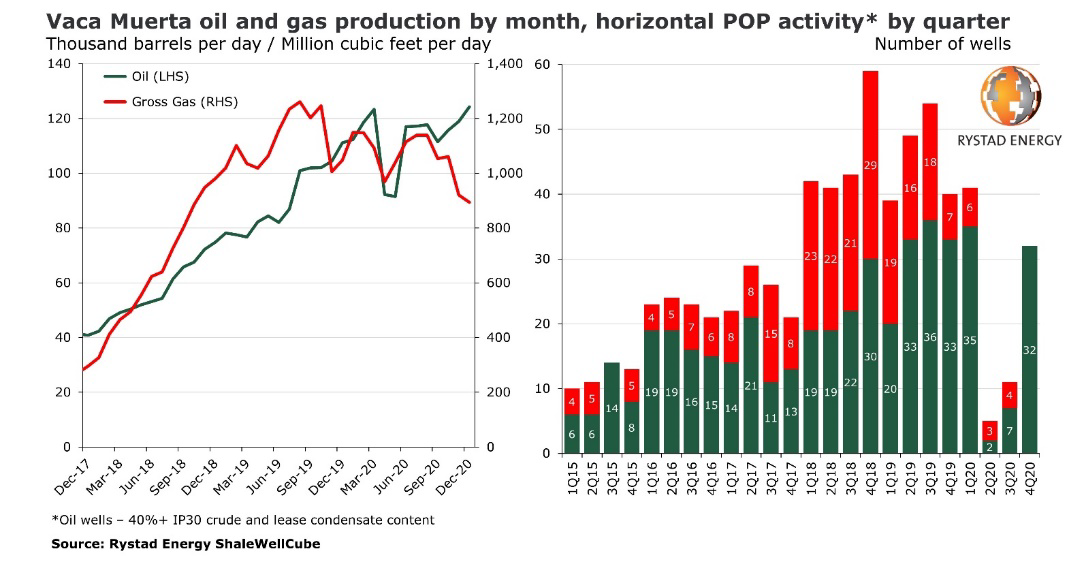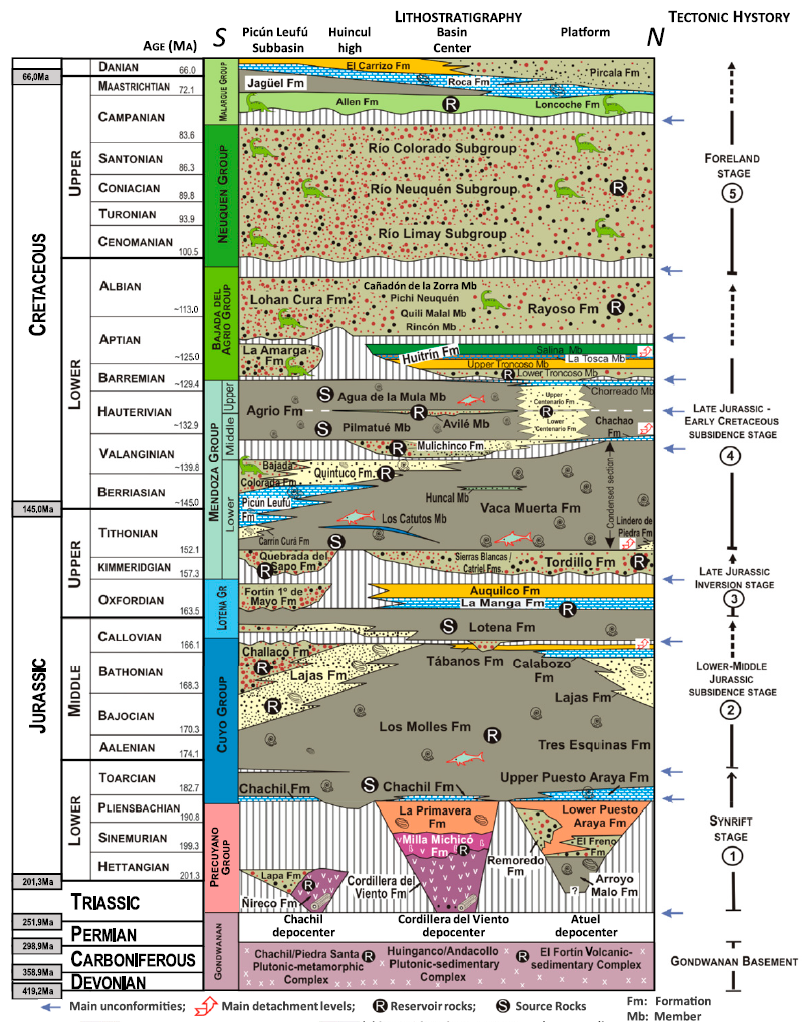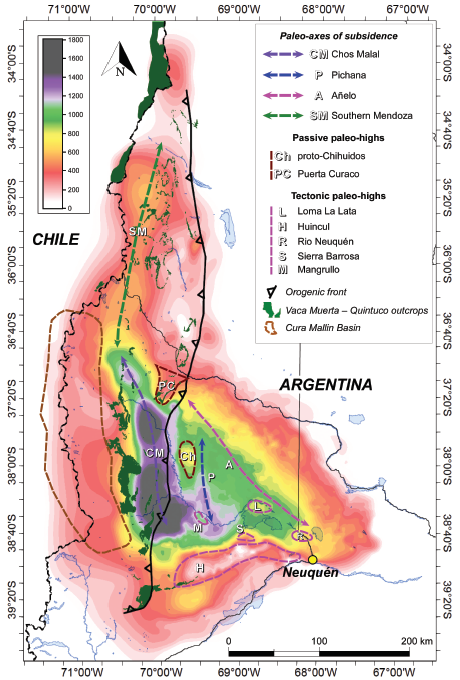Vaca Muerta, La Luna Shale, South America
By Jason Flaum, U.S. Geological Survey, Denver, CO, USA
While recent volatility in the oil and gas industry has resulted in industry minimizing exploration and development efforts (Figure 1), the Vaca Muerta Play remains one of the most prolific unconventional reservoirs outside of North America. At over 500 m thick with multiple stacked organic-rich intervals, the Vaca Muerta has garnered interest from international oil and gas companies such as ExxonMobil, Chevron, TOTAL, YPF, and Repsol, as well as numerous independents. Despite the decrease in drilling activity, significant efforts continue towards improving our understanding of the heterogeneous nature of this formation and optimizing exploration and development efforts when economic conditions improve. This summary focuses on these efforts and how they have impacted current and future development plans.
The Vaca Muerta Formation is a late Jurassic through Early Cretaceous mudstone deposited within the Neuquén Basin, Argentina. Development of the Neuquén Basin began with Late Triassic rifting and continued through its current “Andean” configuration. The basin sits on top of a Devonian – Late Triassic metamorphic and plutonic basement[1]. From the Early Jurassic through the Late Cretaceous, greater than 6 km of sediment filled the basin over the course of 5 major tectonic stages (Figure 2). Much of the tectonic history throughout the Mesozoic was influenced by high rates of thermal subsidence associated with the break-up of Pangea and the formation of a magmatic arc along the western edge of Gondwana[2]. Intervals of subsidence and concomitant marine incursions resulted in the deposition of three prolific source rocks including the Early Jurassic Los Molles, the Late Jurassic – Early Cretaceous Vaca Muerta, and the Early Cretaceous Agrio Formations (Figure 2). While each of these units is a proven source rock across multiple plays, the Vaca Muerta is widely regarded as the most prolific with the highest potential for unconventional development[3][4].
Since the initial discovery at the Plaza Huincal Field in 1918, over 14 billion barrels oil equivalent (BBOE) have been discovered in the Neuquén Basin within multiple stacked petroleum systems from the Early Jurassic through the Cretaceous (Figure 2). Over the past 15 years, technological advances from shale development in North America have been deployed to the Vaca Muerta Play, widely recognized as a world-class source rock and now one of the unconventional reservoirs with the highest potential globally. Recent assessments have estimated the undiscovered technically recoverable resource estimates of the Vaca Muerta at between 14.4 and 15.9 BBOE of oil and 38 – 46 trillion cubic feet (TCF) of gas[5][6].
During deposition of the Vaca Muerta Formation, the Neuquén Basin was a triangular shaped retro-arc basin (Figure 3). The unique configuration of this basin along the western margin of South America was directly related to the confluence of a north – northwest rift system truncated by an east – west system developed between crustal terranes forming the basin basement[7]. Combined with variable rates of thermal subsidence throughout the Late Jurassic through Early Cretaceous, the tectonic regimes exerted a first order control on the stratigraphic and sedimentologic variability observed throughout the formation[8].
Variability in sediment provenance and distribution has been well established via outcrop observations dating to the early 1900s across the basin. Over the past 20 years, seismic imaging and mapping, as well as petrophysical evaluation and log correlation, has focused upon the intervals observed within the Vaca Muerta in an effort to better define and predict the distribution of the high-quality reservoir units[8]. These efforts have resulted in a detailed stratigraphic framework that accounts for the multiple cycles and directions of clinoform geometries observed across the basin (Figure 4). Petrophysical evaluations have suggested that the highest reservoir quality occurs within the mixed siliceous and calcareous organic-rich facies that occur within proximal bottom sets and basal foresets of the progradational clinoform units[9][10][11] (Figure 5).
Early exploration and development focused almost exclusively upon the organic-rich bottom set intervals described above. Thirty-year EURs from these wells compare favorably with all of the most prolific North American shale plays, with the average 10000 ft lateral well estimated to produce ~ 644,000 BOE combined oil and gas[3] (Figure 6) proving the Vaca Muerta play as one of the most prolific unconventional resources in the world. However, as acreage across regions containing high-quality bottomset facies was quickly acquired, companies began to evaluate the potential for high quality reservoir units in other parts of the depositional system.
The stratigraphic and sedimentologic variability of the Vaca Muerta Formation linked to the unique tectonic setting is highly complex and has resulted in significant efforts in re-defining sweet spots outside of the bottomsets mentioned above[8][9]. Further evaluation of the heterogeneous nature of the lithologies that comprise this formation have demonstrated that high quality reservoirs may exist across multiple lithologies and depositional environments (Figure 5). Recent work by Minisini et al.[9] evaluating facies variability throughout the Vaca Muerta Play suggested three new play concepts along the foresets of progradational clinoforms (Figure 7) based upon detailed core and thin section descriptions. These play concepts include thin carrier beds within organic-rich units, tight reservoirs within the middle foresets, and stacking of quality reservoirs within specific foresets. Further exploration of these new play concepts is supported by recognition that many of the highest producing wells in the play occur outside of the areas of thickest TOC accumulation (Figure 8). Recognition of these concepts and resultant exploration and development of them may continue to add to the remaining potential of this world-class unconventional reservoir.
References[edit]
- ↑ Domínguez, R. F., H. A. Leanza, M. Fantín, D. Marchal, and E. Cristallini, 2020a, Basin configuration during the Vaca Muerta times, in D. Minisini, M. Fantín, I. L. Noguera, and H. A. Leanza, eds., Integrated geology of unconventionals: The case of the Vaca Muerta play, Argentina: AAPG Memoir 121, p. 141–162.
- ↑ Veiga, R. D., G. D. Vergani, I. E. Brisson, C. E. Macellari, and H. A. Leanza, 2020, The Neuquen Super Basin: AAPG Bulletin, v. 104, no. 12, p 2521–2555
- ↑ 3.0 3.1 Zborowski, M., 2018, How Does Vaca Muerta Stack Up vs. US Shale? Data Tell the Tale, Journal of Petroleum Technology, from How Does Vaca Muerta Stack Up vs. US Shale? Data Tell the Tale: SPE Journal of Petroleum Technology, December 2018
- ↑ Rystad Energy, 2021, Argentina’s Vaca Muerta tight oil deposit is now producing at record levels, matching US well scores: American Journal of Transportation
- ↑ Schenk, C. J., T. R. Klett, M. E. Tennyson, T. J. Mercier, J. K. Pittman, S. B. Gaswirth, T. M. Finn, M. E. Brownfield, P. A. Le, H. M. Leathers-Miller, and K. R. Marra, 2017, Assessment of Continuous Oil and Gas Resources in the Neuquen Basin Province, Argentina, 2016: [usgs.gov USGS Fact Sheet], FactSheet_3col v. 4.1
- ↑ Mayol, J. C., N. Moridis, D. A. McVay, and J. W. Lee, 2020, Assessment of Oil and Gas Resources in the Vaca Muerta Shale, NeuquénBasin, Argentina: SPE Symposium on Latin American and Caribbean Petroleum Engineering Conference, SPE Paper 199035, July 27-31, 2020.
- ↑ Ramos, V. A., M. Naipauer, H. A. Leanza, and M. E. Sigismondi, 2020, An exceptional tectonic setting along the Andean continental margin, in D. Minisini, M. Fantín, I. L. N., and H. A. Leanza, eds., Integrated geology of unconventionals: The case of the Vaca Muerta play, Argentina: AAPG Memoir 121, p. 25–38.
- ↑ 8.0 8.1 8.2 Domínguez, R. F., O. Catuneanu, H. M. Reijenstein, R. Notta, and H. W. Posamentier, 2020b, Sequence stratigraphy and the three-dimensional distribution of organic-rich units, in D. Minisini, M. Fantín, I. L. Noguera, and H. A. Leanza, eds., Integrated geology of unconventionals: The case of the Vaca Muerta play, Argentina: AAPG Memoir 121, p. 163–200.
- ↑ 9.0 9.1 9.2 Minisini, D., P. Desjardins, G. Otharán, M. Paz, D. Kietzmann, G. Eberli, C. Zavala, T. Simo, J. H. Macquaker, and C. Heine, 2020, Sedimentology, depositional model, and implications for reservoir quality, in D. Minisini, M. Fantín, I. L. Noguera, and H. A. Leanza, eds., Integrated geology of unconventionals: The case of the Vaca Muerta play, Argentina: AAPG Memoir 121, p. 201–236.
- ↑ Romero-Sarmiento, M.-F., S. Ramiro-Ramirez, G. Berthe, M. Fleury, and R. Littke, 2017, Geochemical and petrophysical source rock characterization of the Vaca Muerta Formation, Argentina: Implications for unconventional petroleum resource estimations: International Journal of Coal Geology, v. 184, p. 27-41.
- ↑ Tenaglia, M., G. P. Eberli, R. J. Weger, L. Rodriguez Blanco, L. E. Rueda Sanchez, and P. K. Swart, 2020, Total organic carbon quantification from wireline logging techniques: A case study in the Vaca Muerta Formation, Argentina: Journal of Petroleum Science and Engineering, v. 194, 107489.


